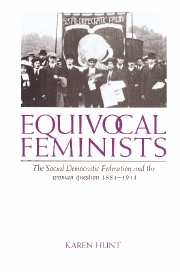Book contents
- Frontmatter
- Contents
- Acknowledgements
- Introduction
- Part 1 The woman question: the theory
- Part 2 The SDF and the woman question: the theory and practice of the party on aspects of the woman question
- 4 The politics of the private sphere
- 5 Women and work
- 6 The suffrage
- Part 3 Women and the SDF: the practical implications of the SDF's understanding of the woman question
- Conclusion
- Appendices
- Bibliography
- Index
6 - The suffrage
Published online by Cambridge University Press: 14 January 2010
- Frontmatter
- Contents
- Acknowledgements
- Introduction
- Part 1 The woman question: the theory
- Part 2 The SDF and the woman question: the theory and practice of the party on aspects of the woman question
- 4 The politics of the private sphere
- 5 Women and work
- 6 The suffrage
- Part 3 Women and the SDF: the practical implications of the SDF's understanding of the woman question
- Conclusion
- Appendices
- Bibliography
- Index
Summary
The enfranchisement of women and their admission to citizenship is an aspect of the woman question which is, by definition, part of the public sphere. The suffrage became an increasingly prominent item on the agenda of all political parties during the lifetime of the SDF and was a subject which much exercised socialists, in Britain and internationally. For the SDF the suffrage, at least in theory, produced a greater degree of unanimity than other aspects of the woman question. But as a practical campaigning issue it exposed fissures in the party and brought into question the credibility of the SDF in the eyes of many women.
From its earliest days the SDF had included in its political programme the demand for universal suffrage. But from the beginning the terms universal or adult suffrage were contested. Although generally defined as the enfranchisement of all male and female adults without property qualification, adult suffrage was taken by some to be synonymous with manhood suffrage. For instance, in the first edition of Justice, Stewart Headlam questioned whether the party programme made it clear that women were included within the demand for universal suffrage. Although it might seem obvious that a demand for adult suffrage necessarily included limited women's suffrage, as contemporary suffragists demanded, yet strategically the two positions came to be seen as counterposed. It is the process whereby the democratic demand for adult suffrage came to be seen by many as the least progressive position which is of interest, because the SDF's strategic thinking on the suffrage reflects many of the same ambivalences that are enshrined in the larger woman question.
- Type
- Chapter
- Information
- Equivocal FeministsThe Social Democratic Federation and the Woman Question 1884–1911, pp. 152 - 184Publisher: Cambridge University PressPrint publication year: 1996

